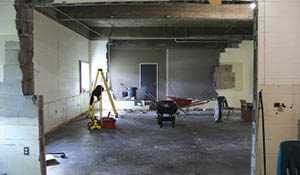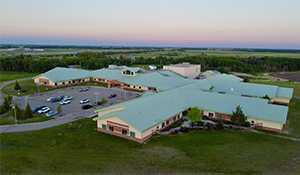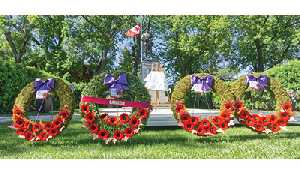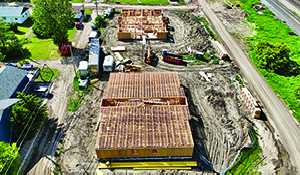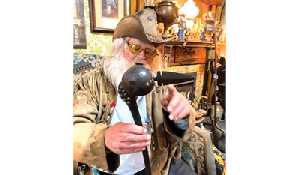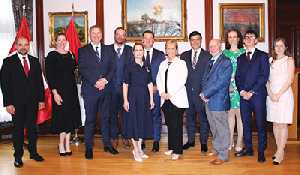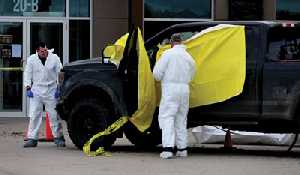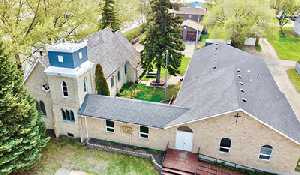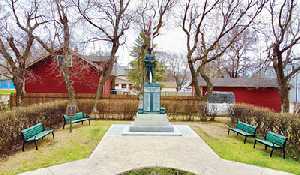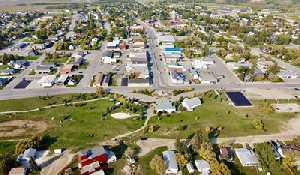Cenotaph rededication this weekend
June 3, 2024, 10:54 am
Ryan Kiedrowski, Local Journalism Initiative Reporter
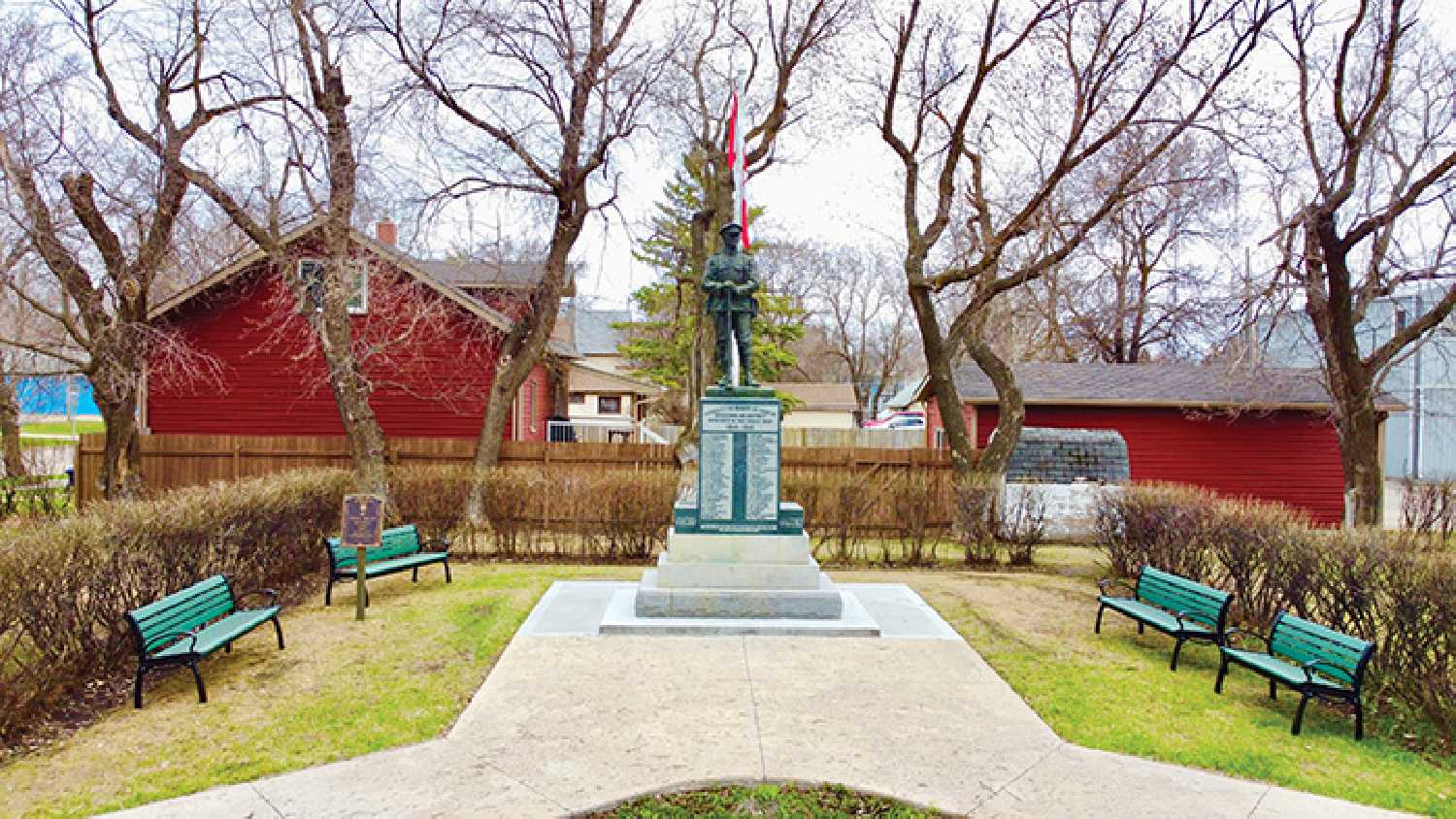

The cenotaph in Moosomin has served as a silent sentinel for almost a century, and this Saturday morning will celebrate 100 years of the landmark’s existence, plus those with local connections that served in overseas conflicts. Another reason to celebrate this historic milestone is the addition of 53 names to the monument —people who served during World War 1.
The actual date of the centennial falls on August 31, however organizers of the Cenotaph Centennial Committee felt an early June date would entice more people to the celebrations. Back in 1924 when the monument was unveiled, 3,000 people witnessed the historic moment - apparently also holding the title of the largest crowd to ever attend a function in Moosomin. A century later, organizers feel that same exuberance has waned unfortunately.
“I would be extremely happy if we probably had three or four hundred people,” said Cenotaph Centennial Committee Chair Brian Beckett.
He points to a bustle of activity in the region, despite careful planning to set a date where the largest amount of people would likely be around Moosomin in order to take part. For awhile, the committee was concerned if the special supper planned after the main ceremonies would even take place due to slow ticket sales.
“It’s been a lot slower than what we were hoping for,” Beckett admits. “There’s a lot going on in town right now, people are doing a lot of donating.”
The committee had big plans for the centennial celebrations, sending out invitations to dignitaries as high up as King Charles III. Moosomin also has strong ties to the 2nd Battalion Princess Patricia’s Canadian Light Infantry, but other duties have called on PPCLI resources for the time being.
“A lot of the regular troops have been assigned to firefighting duties, so I think we have got 14 of the senior ranks coming out for the afternoon event,” Beckett explained.
A hopeful plan to have a flyby of either a Harvard 2 or Hawk aircraft from CFB Moose Jaw or Winnipeg has also been dashed, in part to ‘financial restrictions’.
“They had it all planned and everything but then we got shut down,” Beckett explained.
Undaunted, a march is slated for June 8 at 10:30 a.m. from the Armoury to the Cenotaph with a ceremony to follow. The procession will include the RCMP, a pipe band, members from the PPCLI, and local Air Cadets providing the colour party. The ceremony itself will be similar to the format of Remembrance Day ceremonies; highlighted with reading the names on the newly-obtained plague that will be on display.
“We finally got our plaque just today, actually, with the extra names that we’re adding on,” Beckett said last week. “We’re going to have it displayed on an easel in front of the Cenotaph so people don’t have to walk behind the Cenotaph to see it once it’s mounted.”
Reflecting on the addition of names and how they relate to extending future Remembrance Day ceremonies, Beckett simply explained, “they did a lot for us, so it’s the least we can do.”
Indeed, gathering to honour those sacrifices made for the current freedom we all enjoy is a mere pittance of time.
From Italy to Moosomin
Planning and fundraising for the cenotaph in Moosomin began in 1919, and four years later a lofty budget of $4,000 (more than $70,000 in current dollars) was set for sculptors and marble firms to present their ideas. The successful bid came from Portage la Prairie, Manitoba through the firm of Quinn & Simpson. They ordered a bronze soldier figure from a foundry in Italy in June of 1923 while work on the granite base began.
Usually such figures as the soldier in bronze were carved in marble at that time, but the expensive decision payed off to use a more durable material. It has lasted 100 years and going strong, after all!
Sergio Vatteroni is the sculptor credited with creating the figure, cast in Florence from a plaster model made in Carrara. After being cast, the statue was shipped via steamer to New York, then Montreal before finally hitting the prairies.
Numerous delays in shipping meant it could not be unveiled on Nov. 11 as planned, rather a date in late August, 1924. Even adding the list of 60 people fallen in service during World War 1 was a tall order for Quinn & Simpson as they were more accustomed to working with much smaller memorials, half the proposed size.
The site where the cenotaph currently stands was not the only location considered. In June, 1923, the committee responsible for the monument sought permission to place it on CPR land, but the railway replied that they felt such a memorial ought to be on Town property. A June 27, 1923 article in the World-Spectator reported the Memorial Committee officially selected on the corner of Broadway Avenue and Carlton Street as the site. At the time, the location was noted as a deep water hole, making the first task at hand filling the area and pouring a concrete base—a landscaping cost of just under $200 - and some 800 loads of earth brought in by horse.
After several delays in the storied journey of the Moosomin War Memorial, Lieutenant Governor Sir Frederick W.G. Haultain and two Victoria Cross recipients unveiled the spectacular new monument on Aug. 31, 1924. Almost 100 ears later, another Lieutenant Governor—Russell Mirasty—is set to be attendance this Saturday.
In his comments during the 1924 unveiling, then mayor Victor McCurdy spoke of the importance of the Moosomin landmark.
”The monument is now complete and it is planned to make this spot beautiful with trees, flowers and green grass—not as a pleasure ground, but as a spot where one may pause in quiet contemplation on this enduring monument to remind all of service and sacrifice,” Mayor McCurdy said. “I would like to say to the young people that in the years to come when, in the natural course, you take over the duties and responsibilities of your parents, you will see that this plot of ground is kept ever green and garnished, and that this emblem of sacrifice is lovingly treated.”
The Manitoba connection
As previously noted, the PPCLI in Shilo has a strong tie to Moosomin, primarily due to one of it’s storied members. Sgt. George Harry Mullin was a Moosomin resident who served in the scout and sniper section of the PPCLI Canadian Expeditionary Force during the First World War.
Sgt. Mullin would go on to receive the Victoria Cross for his bravery on Oct. 30, 1917 on the battlefront near Passchendaele. On that date, a company of the PPCLI was trying to take a German ‘pillbox’ fortification that was blocking their advance, also noted as having caused heavy casualties.
While one group of Patricia’s made their frontal attack, Sgt. Mullin approached from the flank, crawling to the top of the concrete building and ‘disposing’ of a sniper while en route. From Sgt. Mullin’s point on top the structure, he shot two German machine gunners with his revolver and convinced the remaining 10 inside the pillbox to surrender.
“For most conspicuous bravery in attack, when single-handed he captured a commanding ‘Pill-box’ which had withstood the heavy bombardment and was causing heavy casualties to our forces and holding up the attack,” noted the Jan. 11, 1918 edition of the London Gazette in recalling the events. “He rushed a sniper’s post in front, destroyed the garrison with bombs, and, crawling on top of the ‘Pill-box,’ he shot the two machine-gunners with his revolver. Sgt. Mullin then rushed to another entrance and compelled the garrison of ten to surrender. His gallantry and fearlessness were witnessed by many, and, although rapid fire was directed upon him, and his clothes riddled by bullets, he never faltered in his purpose and he not only helped to save the situation, but also indirectly saved many lives.”
Sgt. Mullin returned to Moosomin after the war, and was appoint Sargeant-at-Arms for the Saskatchewan Legislature in 1934. He was also at the Moosomin cenotaph unveiling in 1924, commanding the Guard of Honour—some 100 former servicemen from the area.
People encouraged to attend
Beckett says anyone is welcome to attend the event on June 8.
“On June 8, the Cenotaph Moosomin will mark the 100th anniversary since its establishment, giving a permanent site for people to remember those that gave their lives in World War I, World War II and the Korean War,” he says. “The day’s events will be marked with ceremonies and military displays beginning at the Cenotaph at 11:00 Hours at which time wreath laying, dedications, and two minutes of silence will be observed. A lunch and meet and greet will follow at the Royal Canadian Legion. During the evening, a black tie dinner will be served followed with entertainment.
“It is hoped that people and their families are able to attend this celebration of the Cenotaph 100th and the honoring of their family members who gave their lives in the protection of peace.”

